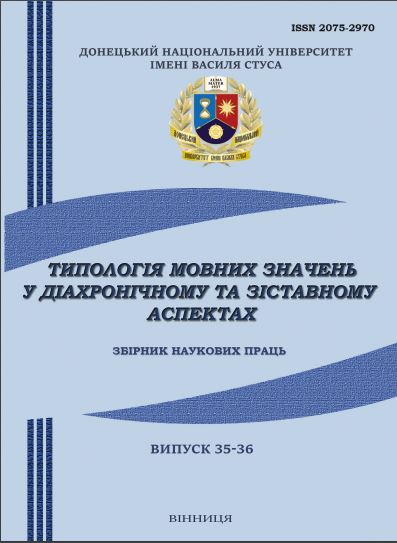Anthropomorphic Metaphors in English Texts of the Informational and Journalistic Genre.
DOI:
https://doi.org/10.31558/2075-2970.2018.35-36.6Keywords:
metaphor, metaphorical transfer models, anthropomorphic metaphor, informational and journalistic texts, source of metaphorical transfer, target of metaphorical transferAbstract
The article is devoted to the study of the anthropomorphic metaphors created by transferring the features of one object to another. Since informational and journalistic texts are one of the main sources of creating new metaphors, the research, study and classification of the metaphors into types is relevant in this genre. Attention is paid to the metaphorical feature transferring models. The objective of the article includes distinguishing of the communicative and structural-semantic patterns of metaphors creation in English newspaper-journalistic texts. The material samples of the research are the metaphorical formations obtained by a continuous sampling from the editions of The Economist Newspapers published in 2013, 2014, and 2017. The author states that the most productive way of metaphors creation occurs, if the source of the borrowed feature describes human physiological conditions. The further perspective of the study involves the research on other types of metaphors in the informational and journalistic texts in English.References
Арутюнова Н. Д. Теория метафоры: Сборник: пер. с англ., фр., нем., исп., польск. яз. Общ. ред. Н. Д. Арутюновой и М. А. Журинской. Москва: Прогресс, 1990. 512 с.
Бессарабова Н. Д. Метафора как языковове явление. Значение и смысл слова: художественная речь, публицистика. Под. ред. Д. Э. Розенталя. Москва: Изд-во МГУ, 1987. 200 с.
Бридсли М. Метафорическое сплетение. Теория метафоры: пер. с англ. Москва: Прогресс, 1990. 201–219 с.
Кабанчук Н. В. Семантична класифікація метафори в публіцистиці на матеріалі англійської та української мов. Науковий вісник Міжнародного гуманітарного університету. Сер.: Філологія. № 10, том 2. 2014.
Кудрявцева Л. А. Метафорические преобразование в современном языке. НДВШ, Филологические науки. № 5. 1988. 62–66 с.
Лакофф Д., Джонсон М. Метафори, якими ми живемо. Теорія метафори. М., 1990. 396 с.
Лакофф Дж. Когнитивная семантика. Язык и интеллект. Москва, 1995.
Скляревская Г. Н. Метафора в системе языка. СПБ. : Наука, 1993. 148 с.
Advanced manufacturing. The Economist Jan. 14th 2017 URL: https://www.economist.com/ news/business/21714394-making-trainers-robots-and-3d-printers-adidass-high-tech-factory-brings-production-back
Cash to the poor. Dec. 12th 2013. The Economist. URL: https://www.economist.com/news/ international/21588385-giving-money-directly-poor-people-works-surprisingly-well-it-cannot-deal
Free exchange. The Economist. Jan. 26th 2017. URL: https://www.economist.com/news/ finance-and-economics/21715654-policymakers-need-consider-quality-well-quantity-jobs-available
India’s meat business. The Economist. Jun. 24th 2017. URL: https://www.economist.com/ news/business/21723859-countrys-slaughterhouses-are-envy-rich-world-indias-huge-buffalo-meatindustry
The generation gain. The Economist. Oct. 28th 2017. URL: https://www.economist.com/ news/finance-and-economics/21730674-gap-closing-millennials-are-doing-better-baby-boomers-did

